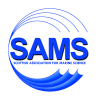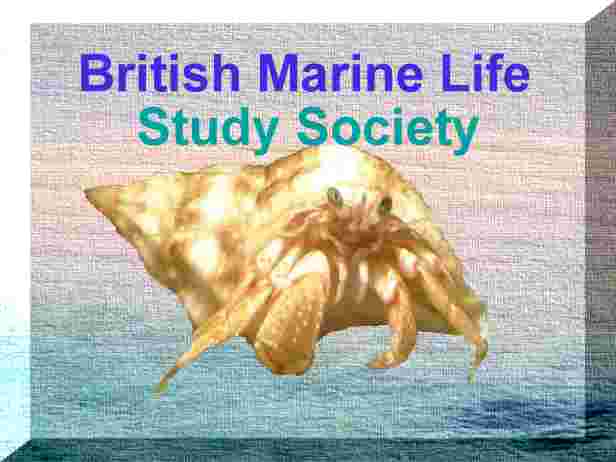-
|

Monthly
electronic news bulletin for the marine life of the NE Atlantic Oceans
including the seas around the British Isles.
The
bulletin is designed for Microsoft Explorer 4 and above using medium fonts
at a resolution of 800 x 600.
Subscribe
and unsubscribe options are at the foot of this page.
|
|
If
you receive this bulletin as an EMail subscriber, you may find the best
way to view the file is on your hard disc in your directory of Incoming
EMails.
|
| MARINE
LIFE NEWS
Reports
of marine wildlife from all around the British Isles, with pollution incidents
and conservation initiatives as they affect the flora and fauna of the
NE Atlantic Ocean.
---------------------------------------------------------------------------------------------------------------------------------
27 December 2002
A
Minke Whale, Balaenoptera acutorostrata,
is
spotted just before midday stranded on some rocks in Portland Harbour,
Dorset. The coastguards were called and they managed to push the whale
back into the water and it spent the rest of the day swimming around the
large natural harbour, but it has yet to be coaxed back out to the open
sea. This species of whale is rarely seen in the shallower parts
of the English Channel.
BBC
News Report
Corrected
Report by Clive Martin (Biscay Dolphin Research Programme)
BMLSS
Cetacea
On
29 December 2002 the whale was not seen in
the harbour and it may have returned to the open sea.
26 December 2002
A group of ten
(including one calf) Bottle-nosed
Dolphins, Tursiops truncatus, are
spotted feeding at the entrance of Aberdeen harbour, north-east Scotland.
22 December
2002
Oiled seabirds,
mainly Guillemots,
are being washed up in greater numbers than normal on the Kent coast. The
RSPCA rehabilitation centre at Mallydams Wood near Hastings, East Sussex,
has already dealt with over 400 birds,
four times the usual number (which was 92 in 2001).
Report Number
Tel: 08705 555 999 (RSPCA)
Report
by the Sandwich Bay Bird Observatory via Kosnet
Full
Report
BMLSS
Oiled Birds Page
17
December 2002
Phocine
Distemper Virus (PDV)
Between
11 December and 17 December there have been
47 dead seals reported around the UK bringing the total to 3682 since the
beginning of the outbreak. The English deaths were down to 16 in the last
week and are falling in Scottish seas after a sharp rise to 133 dead carcasses
in the week ending
4 December 2002.
It
is the total number of dead seals reported, irrespective of what they died
of and this recent rise of mortality in Scottish seals has probably got
more to do with the Grey Seal pupping period than any extra spread of the
virus.
Weekly
Graph (epidemic started 14 August 2002)
PDV
Update
Status
Report 19
BMLSS
Seals
12 December 2002
Early in the
morning a young eight metre long Humpback
Whale, Megaptera
novaengliae, entered the naval harbour of
Frederikshavn on the northern Kattegat coast of Denmark. It remained in
the harbour for the whole of the day and is believed to be feeding on the
shoals of small fish seen. These whales are rarely seen around the mainland
British Isles.
Video
Footage
Cornish
Humpback
BMLSS
Cetacea News
11
December 2002
Taking
up this theme of the wildlife that surrounds us, but which is terra incognito
to most of us amateur naturalists, Barry Collins
(wildlife warden for Thorney Island) contributes
an apt example from his observation of a marker post recently washed up
on the Pilsey Sands in Chichester Harbour, Sussex. The section of the post
which had for years been under water was covered with a thousand
Goose
Barnacles, Lepas anatifera, looking like silvery grey
mussel
shells around 5 cm (2 inches) long, each attached to the post by a long
flexible brown stem which may be 20 cm (8 inches) long allowing the living
crustacean to reach out into the surrounding water to feed.
NB: On
previous occasions, local buoys thought to have provided habitats for Lepas
have
discovered top be buoys from much further afield, e.g. meteorological buoys
from the Atlantic Ocean.
BMLSS
Barnacles
5 December 2002
In the last
few weeks 640 oiled sea birds have
been washed up on the East Anglian coasts of Suffolk and Norfolk. The source
of the oil has not been discovered, but it is believed to have been released
from an old wreck.
BBC
Television News Report
The Maritime
& Coastguard Agency have made sent up spotter
planes and received reports of slicks of oil on 19
and 21 November 2002, relatively small ones
compared to a major disaster.
Report
from Tony Child (Thanet
Coast Project Officer)
BMLSS
Oil Spills Page

|
| PICTURE
GALLERY
Each
month, at least one special marine image will be published from images
sent to the BMLSS. This
can be of the seashore, undersea world or any aspect of the marine natural
world, especially the underwater life, but not restricted to life beneath
the waves. Topical inclusions may be included instead of the most meritorious,
and images will be limited to the NE Atlantic Ocean and adjoining sea species
and landscapes.

Berthella
plumula
Photograph
by Steve Trewhella, of Poole, Dorset
This
strange looking mollusc was photographed in
Dorset where they seem to be common
on
the shore at low tide and in certain times of the year. It is one of
the
sea
slugs or opisthobranchs
(family: Pleurobranchidae), gastropods
that have lost their shells or in this family have retained a thin internal
transparent shell.
Rockpoolers
are most likely to discover this species under rocks on the lower shore
when the spring
tide
recedes. It is not to be discovered on every rock coast though. Divers
may also discover this small, up to 6 cm, animal, which is one of the largest
of the sea slugs. Despite, being reasonably common where found its biology
seems to be little known. Many of these sea slugs are specialist feeders
and this one feeds on the sponge Oscarella.
Sea
Slug Forum Information Page
---------------------------------------------------------------------------------------------------------------------------------
Seashore
Images

Rocky
Shore at Cullercoats, Tyneside
Photograph
by Andy Horton
The
name of the particular coast should be included and the grid reference,
if known. Print photographs can be included in Exhibitions
and on the BMLSS Web Sites and electronic publications. Electronic images
in *.JPG format can also be considered for the web site. They should not
exceed 150K in size.
 Click
on the album for more links (On-line link) Click
on the album for more links (On-line link)

|
| DIARY
In
chronological order, the most recent events are at the top of the page.
Events open to the public, free or for a nominal charge only are included.
Most Seminars need to be booked in advance.
---------------------------------------------------------------------------------------------------------------------------------
BIOSIS
Conference Calendar for Zoology
(Major
Link of all biological conferences around the world)
---------------------------------------------------------------------------------------------------------------------------------
 SAMS
Seminar Series SAMS
Seminar Series
The Scottish
Association for Marine Science (SAMS)
Dunstaffnage Marine Laboratory, Dunbeg,
Oban, Argyll PA37 1QA
Tel: 01631 559000 Fax: 01631 559300
Email: mail@dml.ac.uk
For more details/how to find SAMS
see our website: http://www.sams.ac.uk
Unless otherwise stated, seminars
are held on Fridays at 4:15 pm
in the SAMS Conference Room
** Followed by the Friday R&R **
For more details
on the forthcoming talks, please contact Murray Roberts (mailto:mr-t@dml.ac.uk)
or tel: 01631 559 000
---------------------------------------------------------------------------------------------------------------------------------

A
series of monthly talks on marine conservation topics
These
talks are open to the public, admission is free.
6 February
2003:
Seabirds
in Hampshire, UK, and beyond – Russel Wynn
6
March 2003
Walking
the dog whelk - Simon Bray
3
April 2003
ROV
deep sea fish watching - Ian Thomas
1
May 2003
Fishy
Tales - Peter Henderson
The
Marine Life Talks are held on the first Thursday of the month at 7.30 pm,
please arrive at 7.15 pm to be met in Reception. Southampton Oceanography
Centre is reached via Dock Gate 4 (between Town Quay and Ocean Village).
|
NEW
PUBLICATIONS & WEB PAGES
Biological
recording software for the new millennium

RECORDER
2000: Littlefield Consultancy pages
Littlefield
Consultancy offers a full range of services for Recorder 2000 users. These
include supplying the software, addins, report writing, data transfer and
training. Support can be tailored to meet your needs, with assistance being
provided at evening and weekends where this is required.
|
SOCIETY
INFORMATION
The
British Marine Life Study Society are responsible for producing the journal
GLAUCUS,
which is the first publication exploring the marine life of the seas surrounding
the British Isles available to the general public.
We
also publish the quarterly SHOREWATCH Newsletter
and
the
TORPEDO
Electronic News Bulletin.
---------------------------------------------------------------------------------------------------------------------------------
Change of EMail
Address
 Please
note that the EMail address for messages to the British Marine
Life Study Society has now changed Please
note that the EMail address for messages to the British Marine
Life Study Society has now changed
from
bmlss@compuserve.com
to Glaucus@hotmail.com
Messages
to the first address will not receive any guarantee of a reply and from
year 2003, the old EMail address is expected to fall into disuse.
---------------------------------------------------------------------------------------------------------------------------------
Membership 2003
Current
members will
have their subscriptions waived for year 2003. An explanation was sent
before Christmas. This is because of he computer breakdown and the failure
of the full complement of paper publications.
|
|
Bulletin
Details
If
you receive this Bulletin direct from the British Marine Life Study Society
it will contain only hypertext and image (*.htm *.gif & *.jpg) files.
Recipients
can only unsubscribe if the Bulletin is received directly from the
BMLSS.
Permission
is granted to forward the Bulletin on unaltered. However, you will have
to include the images separately.
Subscribe/Unsubcribe
http://groups.yahoo.com/group/BMLSS-Torpedo
To
save download times, only new images are included with each Bulletin.
The
Bulletin is designed to be viewed on Internet Explorer using medium
fonts
at a resolution
of 800 x 600. Viewing should be possible on Netscape and other browsers. |
| Printing
the two column version of Torpedo (from issue 28)
These
pages are not designed for the default settings on the Page Set-ups of
your browser. I recommend viewing in Microscope Internet Explorer 6 and
altering the right and left hand columns in the Page Set-up menu to 9 mm
(from 19 mm).
The
page set-up can also be amended in Netscape Composer and other web page
editors, and this has the advantage of enabling the specified number of
pages to be printed and the information about the file (name, path, date)
to be deleted.
Some
of the images may not display if you have changed your directory for downloaded
files. The images may also not display properly if your settings on your
EMail software do not allow you do this automatically. When received in
Pegasus the format is changed slightly, but the bulletin is still readable.
|
---------------------------------------------------------------------------------------------------------------------------------
Compiled
on Netscape Composer 4.7 and other programs
|












